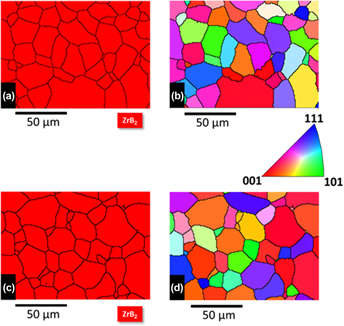Published online by Cambridge University Press: 10 June 2016

The slip systems in ZrB2 flexural tested at 1000 °C and 1500 °C have been quantified. The dislocations in both samples were long and straight with a dislocation density of approximately 1013 m−2. The structure of the dislocations as well as the low density is in agreement with a ceramic that is hard and brittle and dislocation nucleation and motion is restricted. The low temperature slip systems were found to include c-prismatic slip—
 ${1 \mathord{\left/ {\vphantom {1 3}} \right. \kern-\nulldelimiterspace} 3}\left[ {0001} \right]\left( {\bar 1010} \right)$
—and a-pyramidal slip—
${1 \mathord{\left/ {\vphantom {1 3}} \right. \kern-\nulldelimiterspace} 3}\left[ {0001} \right]\left( {\bar 1010} \right)$
—and a-pyramidal slip—
 ${1 \mathord{\left/ {\vphantom {1 3}} \right. \kern-\nulldelimiterspace} 3}\left[ {11\bar 20} \right]\left( {\bar 1101} \right)$
whereas the elevated temperature sample revealed a-basal slip—
${1 \mathord{\left/ {\vphantom {1 3}} \right. \kern-\nulldelimiterspace} 3}\left[ {11\bar 20} \right]\left( {\bar 1101} \right)$
whereas the elevated temperature sample revealed a-basal slip—
 ${1 \mathord{\left/ {\vphantom {1 3}} \right. \kern-\nulldelimiterspace} 3}\left[ {11\bar 20} \right]\left( {0001} \right)$
. Density functional theory Generalized Stacking Fault Energy curves for perfect slip were calculated and agreed well with geometric considerations for slip, including interplanar spacing and planar packing. Though basal slip has the lowest fault energy, the presence of the other dislocation types is suggestive that the activation barrier is not a hindrance for the temperatures studied and is likely activated to increase the number of plastic degrees of freedom.
${1 \mathord{\left/ {\vphantom {1 3}} \right. \kern-\nulldelimiterspace} 3}\left[ {11\bar 20} \right]\left( {0001} \right)$
. Density functional theory Generalized Stacking Fault Energy curves for perfect slip were calculated and agreed well with geometric considerations for slip, including interplanar spacing and planar packing. Though basal slip has the lowest fault energy, the presence of the other dislocation types is suggestive that the activation barrier is not a hindrance for the temperatures studied and is likely activated to increase the number of plastic degrees of freedom.